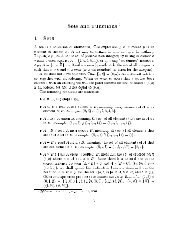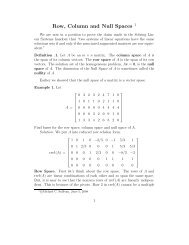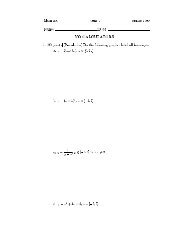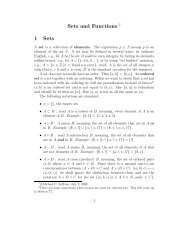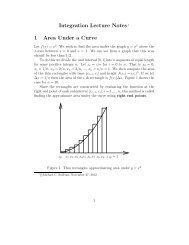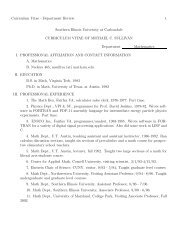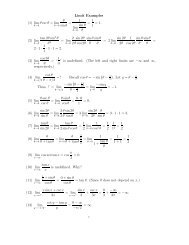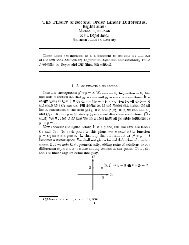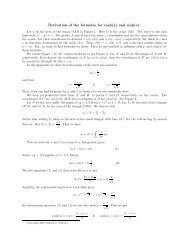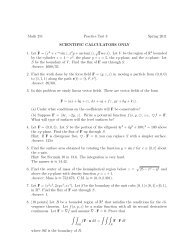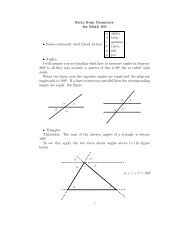Lorenz like Smale flows on three-manifolds - Michael Sullivan
Lorenz like Smale flows on three-manifolds - Michael Sullivan
Lorenz like Smale flows on three-manifolds - Michael Sullivan
Create successful ePaper yourself
Turn your PDF publications into a flip-book with our unique Google optimized e-Paper software.
Topology and its Applicati<strong>on</strong>s 156 (2009) 2462–2469C<strong>on</strong>tents lists available at ScienceDirectTopology and its Applicati<strong>on</strong>swww.elsevier.com/locate/topol<str<strong>on</strong>g>Lorenz</str<strong>on</strong>g> <str<strong>on</strong>g>like</str<strong>on</strong>g> <str<strong>on</strong>g>Smale</str<strong>on</strong>g> <str<strong>on</strong>g>flows</str<strong>on</strong>g> <strong>on</strong> <strong>three</strong>-<strong>manifolds</strong>Bin YuT<strong>on</strong>gji Department of Mathematics, T<strong>on</strong>gji University, Shanghai 200092, PR Chinaarticle info abstractArticle history:Received 2 March 2009Received in revised form 3 July 2009Accepted 3 July 2009MSC:57N1058K0537E9937D45In this paper, we discuss how to realize <str<strong>on</strong>g>Lorenz</str<strong>on</strong>g> <str<strong>on</strong>g>like</str<strong>on</strong>g> <str<strong>on</strong>g>Smale</str<strong>on</strong>g> <str<strong>on</strong>g>flows</str<strong>on</strong>g> (LLSF) <strong>on</strong> 3-<strong>manifolds</strong>.It is an extensi<strong>on</strong> of M. <strong>Sullivan</strong>’s work about <str<strong>on</strong>g>Lorenz</str<strong>on</strong>g> <str<strong>on</strong>g>Smale</str<strong>on</strong>g> <str<strong>on</strong>g>flows</str<strong>on</strong>g> <strong>on</strong> S 3 . We focus <strong>on</strong>two questi<strong>on</strong>s: (1) Classify the topological c<strong>on</strong>jugate classes of LLSF which can be realized<strong>on</strong> S 3 ; (2) Which 3-<strong>manifolds</strong> admit LLSF? If some 3-manifold admits LLSF, how does itadmit LLSF? This paper is in some sense parallel to the work of J. Morgan and M. Wada <strong>on</strong>Morse–<str<strong>on</strong>g>Smale</str<strong>on</strong>g> <str<strong>on</strong>g>flows</str<strong>on</strong>g> <strong>on</strong> 3-<strong>manifolds</strong>.© 2009 Elsevier B.V. All rights reserved.Keywords:<str<strong>on</strong>g>Lorenz</str<strong>on</strong>g> <str<strong>on</strong>g>like</str<strong>on</strong>g> <str<strong>on</strong>g>Smale</str<strong>on</strong>g> <str<strong>on</strong>g>flows</str<strong>on</strong>g>TemplatesThree-<strong>manifolds</strong>Knots1. Introducti<strong>on</strong>Many papers about <str<strong>on</strong>g>flows</str<strong>on</strong>g> <strong>on</strong> <strong>three</strong>-<strong>manifolds</strong> are about the realizati<strong>on</strong> of some types of <str<strong>on</strong>g>flows</str<strong>on</strong>g> <strong>on</strong> <strong>three</strong>-<strong>manifolds</strong>.J. Morgan [13] studied which <strong>three</strong>-<strong>manifolds</strong> admit n<strong>on</strong>-singular Morse–<str<strong>on</strong>g>Smale</str<strong>on</strong>g> <str<strong>on</strong>g>flows</str<strong>on</strong>g> (NMSF) using round handle decompositi<strong>on</strong>.Following J. Morgan’s work, M. Wada [17] systematically studied how to realize NMSF <strong>on</strong> S 3 . M. Handel andW.P. Thurst<strong>on</strong> [12], Goodman [11] c<strong>on</strong>structed some <strong>three</strong>-<strong>manifolds</strong> which admit Anosov <str<strong>on</strong>g>flows</str<strong>on</strong>g>.J. Franks [5] systematically studied how to realize n<strong>on</strong>-singular <str<strong>on</strong>g>Smale</str<strong>on</strong>g> <str<strong>on</strong>g>flows</str<strong>on</strong>g> (NSF) <strong>on</strong> S 3 via Lyapunov graph. However,this method doesn’t include embedding informati<strong>on</strong>. On the other hand, J. Franks [6,7] used homology to describe someembedding informati<strong>on</strong>.Similar to M. Wada’s work about the realizati<strong>on</strong> of NMSF <strong>on</strong> S 3 , M. <strong>Sullivan</strong> [16] studied a special type of NSF <strong>on</strong> S 3 .This type of NSF is called <str<strong>on</strong>g>Lorenz</str<strong>on</strong>g> <str<strong>on</strong>g>Smale</str<strong>on</strong>g> <str<strong>on</strong>g>flows</str<strong>on</strong>g>. A <str<strong>on</strong>g>Lorenz</str<strong>on</strong>g> <str<strong>on</strong>g>Smale</str<strong>on</strong>g> flow is a <str<strong>on</strong>g>Smale</str<strong>on</strong>g> flow with <strong>three</strong> basic sets: a repelling orbit,an attracting orbit, and a n<strong>on</strong>-trivial saddle set modeled by a <str<strong>on</strong>g>Lorenz</str<strong>on</strong>g> template.In this paper, we discuss how to realize <str<strong>on</strong>g>Lorenz</str<strong>on</strong>g> <str<strong>on</strong>g>like</str<strong>on</strong>g> <str<strong>on</strong>g>Smale</str<strong>on</strong>g> <str<strong>on</strong>g>flows</str<strong>on</strong>g> (LLSF) <strong>on</strong> 3-<strong>manifolds</strong>. It is an extensi<strong>on</strong> of M. <strong>Sullivan</strong>’swork [16] about <str<strong>on</strong>g>Lorenz</str<strong>on</strong>g> <str<strong>on</strong>g>Smale</str<strong>on</strong>g> <str<strong>on</strong>g>flows</str<strong>on</strong>g> <strong>on</strong> S 3 . A LLSF is a NSF with <strong>three</strong> basic sets: a repelling orbit r, an attracting orbit a,and a n<strong>on</strong>-trivial saddle set modeled by a <str<strong>on</strong>g>Lorenz</str<strong>on</strong>g> <str<strong>on</strong>g>like</str<strong>on</strong>g> template. Disregarding embedding informati<strong>on</strong>, there are <strong>three</strong> typesof <str<strong>on</strong>g>Lorenz</str<strong>on</strong>g> <str<strong>on</strong>g>like</str<strong>on</strong>g> templates: <str<strong>on</strong>g>Lorenz</str<strong>on</strong>g> template L(0, 0), horseshoe template L(0, 1), and template L(1, 1). WedenotebyL(i, j)a <str<strong>on</strong>g>Lorenz</str<strong>on</strong>g> <str<strong>on</strong>g>like</str<strong>on</strong>g> template whose saddle set is modeled by <str<strong>on</strong>g>Lorenz</str<strong>on</strong>g> <str<strong>on</strong>g>like</str<strong>on</strong>g> template L(i, j). We focus <strong>on</strong> two questi<strong>on</strong>s: (1) Classifythe topological c<strong>on</strong>jugate classes of LLSF which can be realized <strong>on</strong> S 3 ; (2) Which 3-<strong>manifolds</strong> admit LLSF? If it admits LLSF,how does it admit LLSF? B. Campos, A. Cordero, J. Martínez Alfaro, P. Vindel [4] studied the same problem as questi<strong>on</strong> (2)E-mail address: binyu1980@gmail.com.0166-8641/$ – see fr<strong>on</strong>t matter © 2009 Elsevier B.V. All rights reserved.doi:10.1016/j.topol.2009.07.008
2464 B. Yu / Topology and its Applicati<strong>on</strong>s 156 (2009) 2462–2469Fig. 2.Fig. 3.Definiti<strong>on</strong> 2.2. For m,n ∈ Z ,denotebyL(m,n) the (m,n) type <str<strong>on</strong>g>Lorenz</str<strong>on</strong>g> <str<strong>on</strong>g>like</str<strong>on</strong>g> template. Herem, n are half-twists number respectively,as Fig. 2 shows.As far as topological classificati<strong>on</strong> is c<strong>on</strong>cerned, there are <strong>on</strong>ly <strong>three</strong> <str<strong>on</strong>g>Lorenz</str<strong>on</strong>g> <str<strong>on</strong>g>like</str<strong>on</strong>g> templates: L(0, 0), L(0, 1) and L(1, 1).L(0, 0) is the <str<strong>on</strong>g>Lorenz</str<strong>on</strong>g> template; L(0, 1) is the <str<strong>on</strong>g>Smale</str<strong>on</strong>g> horseshoe template. M. <strong>Sullivan</strong> studied simple <str<strong>on</strong>g>Smale</str<strong>on</strong>g> flow <strong>on</strong> S 3 in thecase the saddle set can be modeled by L(0, 0). So we can restrict our discussi<strong>on</strong> to L(0, 1) and L(1, 1). Ifweembedthesetemplates to S 3 , then we can denote them by L(m,n). Herem, n are half-twists number of two bands of the template.For a <str<strong>on</strong>g>Lorenz</str<strong>on</strong>g> <str<strong>on</strong>g>like</str<strong>on</strong>g> <str<strong>on</strong>g>Smale</str<strong>on</strong>g> flow, an isolating neighborhood of the saddle set can be regarded as a thickened <str<strong>on</strong>g>Lorenz</str<strong>on</strong>g> <str<strong>on</strong>g>like</str<strong>on</strong>g>template. The isolating neighborhood is a genus two handlebody with flow. The points in the boundary of the isolatingneighborhood where the flow is transverse outward (inward) is called the exit set (entrance set). The exit set and the entranceset intersect in a finite uni<strong>on</strong> of closed curves. There are two cases: L(0, 1) and L(1, 1), we denote their neighborhoods byM and N respectively. The exit set and the entrance set of M (N) aredenotedbyX and Y respectively. The core of X isdenoted by C; the intersecti<strong>on</strong> of X and Y , which c<strong>on</strong>sists of closed curves b, c and d, is denoted by S. The fundamentalgroup of M (N) isZ ∗ Z =〈x, y〉. The basic point is P . See Fig. 3.3. The realizati<strong>on</strong> of <str<strong>on</strong>g>Lorenz</str<strong>on</strong>g> <str<strong>on</strong>g>like</str<strong>on</strong>g> <str<strong>on</strong>g>Smale</str<strong>on</strong>g> <str<strong>on</strong>g>flows</str<strong>on</strong>g> <strong>on</strong> S 3The basic facts about <strong>three</strong>-<strong>manifolds</strong> used in this paper can be found in [9,10].
B. Yu / Topology and its Applicati<strong>on</strong>s 156 (2009) 2462–2469 2465Fig. 4.Lemma 3.1. Let W = D 2 ( q 1p 1, q 2qp 2) be a Seifert manifold with orbit-manifold a disk and with two excepti<strong>on</strong>al fibers. 1 q, 2are slopesp 1 p 2of these two excepti<strong>on</strong>al fibers. p 1 and p 2 are coprime. Given two integers s, t such that p 1 s − p 2 t = 1. Then W is a knot complementspace if and <strong>on</strong>ly if q 1 ≡−t (mod p 1 ),q 2 ≡ s (mod p 2 ) or q 1 ≡ t (mod p 1 ),q 2 ≡−s (mod p 2 ). Furthermore, if W is a knotcomplement space, the knot must be a (p 1 , p 2 ) type torus knot.Proof. π 1 (W ) ={x, y | x p 1= y p 2}. Hence if W is a knot complement space the knot must be (p 1 , p 2 ) torus knot.See [3, Lemma 15.37, Corollary 15.23]. Some standard computati<strong>on</strong>s show a (p 1 , p 2 ) type knot complement space can bewritten as D 2 ( −tp 1, sp 2). By Propositi<strong>on</strong> 2.1, Theorem 2.3 in Chapter 2 of [8] and computati<strong>on</strong>s above, it is easy to show W isa knot complement space if and <strong>on</strong>ly if q 1 ≡−t (mod p 1 ), q 2 ≡ s (mod p 2 ) or q 1 ≡ t (mod p 1 ), q 2 ≡−s (mod p 2 ).Inthesecases, the knot must be a (p 1 , p 2 ) type torus knot. ✷Let A (R) be a can<strong>on</strong>ical neighborhood of a closed attractor (repeller) and a (r) is the core of A (R). A (R) isasolidtoruswith flow which is transverse inward (outward) to ∂ A (∂ R). To c<strong>on</strong>struct <str<strong>on</strong>g>Lorenz</str<strong>on</strong>g> <str<strong>on</strong>g>like</str<strong>on</strong>g> <str<strong>on</strong>g>Smale</str<strong>on</strong>g> <str<strong>on</strong>g>flows</str<strong>on</strong>g> <strong>on</strong> S 3 , we first attach theclosure of the exit set of a thickened <str<strong>on</strong>g>Lorenz</str<strong>on</strong>g> <str<strong>on</strong>g>like</str<strong>on</strong>g> template M (N) to∂ A. We denote the attached space MA (NA).Lemma 3.2. MA (NA) can be regarded as part of a <str<strong>on</strong>g>Lorenz</str<strong>on</strong>g> <str<strong>on</strong>g>like</str<strong>on</strong>g> <str<strong>on</strong>g>Smale</str<strong>on</strong>g> flow <strong>on</strong> S 3 if and <strong>on</strong>ly if the interior of MA (NA) is homeomorphicto the complement of a knot in S 3 .Proof. If MA (NA) is a building block of a <str<strong>on</strong>g>Lorenz</str<strong>on</strong>g> <str<strong>on</strong>g>like</str<strong>on</strong>g> <str<strong>on</strong>g>Smale</str<strong>on</strong>g> flow <strong>on</strong> S 3 ,thenMA can be regarded as the closure of thecomplement of R in S 3 . The core of R is a knot in S 3 . The “<strong>on</strong>ly if ” part is proved.The “if ” part is easy to prove by attaching R to MA (NA) such that its core is the knot and its boundary is attached tothe boundary of MA (NA). ✷Lemma 3.2 is the key. We will discuss all possible c<strong>on</strong>figurati<strong>on</strong>s of MA and NA using Lemma 3.2 to decide which <strong>on</strong>escan be realized in a <str<strong>on</strong>g>Lorenz</str<strong>on</strong>g> <str<strong>on</strong>g>like</str<strong>on</strong>g> <str<strong>on</strong>g>Smale</str<strong>on</strong>g> flow <strong>on</strong> S 3 .Attaching i-handle is a useful surgery in our arguments below. An i-handle, 1 i 3, is an i-ball of form D i × D 3−i .Theindex i indicates the intenti<strong>on</strong> to attach it to something else al<strong>on</strong>g the S i−1 × D 3−i part of its boundary. More detail can befoundinChapter11of[15].Case 1. MA (the proof of Theorem 1).In this case, the core C is two circles c 1 , c 2 c<strong>on</strong>nected by an arc l, c 1 is homotopic to x in M. TheexitsetX is the uni<strong>on</strong>of <strong>three</strong> sets: c 1 , c 2 and l. Herec 1 , c 2 and l are homeomorphic to c 1 ×[0, 1], c 2 ×[0, 1] and l ×[0, 1] respectively.Case 1.1. c 1 , c 2 both are inessential in ∂ A. There are <strong>three</strong> subcases, as Fig. 4 shows.We attach 2-handles D 1 and D 2 to M al<strong>on</strong>g c 1 and c 2 respectively, we call it M ′ . In subcase (1.1.1), MA is homeomorphicto the manifold which is c<strong>on</strong>structed by attaching 1-handle D 3 to M ′ in l; in subcase (1.1.2), MA is homeomorphic tothe manifold which is c<strong>on</strong>structed by attaching 1-handle D 3 to M ′ in D 1 ; in subcase (1.1.3), MA is homeomorphic to themanifold which is c<strong>on</strong>structed by attaching 1-handle D 3 to M ′ in D 2 . Actually, in any subcase above, MA is homeomorphicto solid torus with core a. So in Case 1, any subcase can be realized as <str<strong>on</strong>g>Lorenz</str<strong>on</strong>g> <str<strong>on</strong>g>like</str<strong>on</strong>g> <str<strong>on</strong>g>Smale</str<strong>on</strong>g> flow <strong>on</strong> S 3 and a ⊔ r is a Hopf linkin S 3 . However, as <str<strong>on</strong>g>flows</str<strong>on</strong>g>, any <strong>on</strong>e of the <strong>three</strong> subcases is not topologically c<strong>on</strong>jugate to the others. In this case, the saddleset is standardly embedded, i.e. the saddle set is modeled by embedded L(0, 1) and the cores of both bands are unknottedand unlinked to each other.Case 1.2. c 2 is inessential in ∂ A, c 1 is essential in ∂ A, as Fig. 5(1.2) shows.Here c 1 is a (p, q) type curve in ∂ A. Becausec 2 is inessential, to visualize MA, we can attach a 2-handle to M al<strong>on</strong>g c 2 ,we call it M ′ . M ′ is a solid torus, c 1 is a l<strong>on</strong>gitude in ∂ M ′ . Then we can see that MA is homeomorphic to a solid torus, sothis case can be realized as <str<strong>on</strong>g>Lorenz</str<strong>on</strong>g> <str<strong>on</strong>g>like</str<strong>on</strong>g> <str<strong>on</strong>g>Smale</str<strong>on</strong>g> flow <strong>on</strong> S 3 and a ⊔ r is a Hopf link in S 3 , c 1 is a (p, q) type torus knot. In thiscase, the saddle set is modeled by embedded L(2p + 2q − 2, 2p + 2q − 1). The cores of two bands are two parallel (p, q)torus knots.Case 1.3. c 1 is inessential in ∂ A, c 2 is essential in ∂ A, as Fig. 5(1.3) shows. Here c 2 is a (p, q) type curve in ∂ A. Bythesame analysis in Case 1.2, we can show that this case can be realized as <str<strong>on</strong>g>Lorenz</str<strong>on</strong>g> <str<strong>on</strong>g>like</str<strong>on</strong>g> <str<strong>on</strong>g>Smale</str<strong>on</strong>g> flow <strong>on</strong> S 3 and a ⊔ r is a Hopf
B. Yu / Topology and its Applicati<strong>on</strong>s 156 (2009) 2462–2469 2467Fig. 7.Fig. 8.Case 2.2. One closed curve in C is inessential in ∂ A and the other two curves are essential in ∂ A. There are two subcases,seeFig.8.Inthesubcase8-1,c 1 c 3 and c 2 c 3 are two parallel (p, q) curves in ∂ A; in the subcase 8-2, c 1 c 2 and c 3 c 2 are twoparallel (p, q) curves in ∂ A. Letπ 1 (A) ={t}.Subcase 2.2.1. As Fig. 8-1 shows, we have that c bounds a disk D in ∂ A. We denote a neighborhood of the disk byB = D × I, I =[0, 1] and denote by NB the manifold N ∪ B through attaching B to N al<strong>on</strong>g ∂ D × I and c. HenceNB c ∼ = A ∪ϕ R,∂NB is a torus and is divided to two annuluses T 1 , T 2 by d, b. Hereϕ : A 1 → A 2 , A 1 is an annulus in ∂ A and A 2 is an annulusin ∂ R.π 1 (NB) ={x, y | xy −1 x = 1} ={x} ∼ = Z .HenceNB is a solid torus, so we can take d as (3, 1) type simple closed curvein ∂NB. d is homotopic to x 3 in the solid torus. NA can be obtained by attaching A to NB al<strong>on</strong>g T 1 .Lets and t be twointegers such that ps − qt = 1. Thus NA ∼ = D 2 ( −23 , −t ). By Lemma 3.1, if NA is homeomorphic to a knot complement space,ptheknotmustbea(3, p) type torus knot and 3, p are coprime. In this case S 3 = NA ∪ R, d is parallel to r. HenceNB ∪ Ris homeomorphic to a solid torus as the same core as NB. Then(NB ∪ R) ∪ A is the standard genus <strong>on</strong>e Heegaard splittingof S 3 . Choosing a suitable coordinate of R, wehaveq = 3orq =−3.If p = 3k − 1, then 3 × k − p × 1 = 1. By Lemma 3.1, NA is homeomorphic to a knot complement space if and <strong>on</strong>ly ift ≡ k(p). Similarly, if p = 3k + 1, NA is homeomorphic to a knot complement space if and <strong>on</strong>ly if t ≡ k(p). a is a (3, 1) typesimple closed curve in ∂NB and is (p, q) type simple closed curve in ∂ A, henceNA is homeomorphic to a knot complementspace if and <strong>on</strong>ly if p | (qk + 1). By Lemma 3.2 and arguments above, if and <strong>on</strong>ly if p = 3k − 1, q =−3orp = 3k + 1, q = 3,NA can be regarded as part of a <str<strong>on</strong>g>Lorenz</str<strong>on</strong>g> <str<strong>on</strong>g>like</str<strong>on</strong>g> <str<strong>on</strong>g>Smale</str<strong>on</strong>g> <str<strong>on</strong>g>flows</str<strong>on</strong>g> <strong>on</strong> S 3 .So in this subcase, if it can be realized as <str<strong>on</strong>g>Lorenz</str<strong>on</strong>g> <str<strong>on</strong>g>like</str<strong>on</strong>g> <str<strong>on</strong>g>Smale</str<strong>on</strong>g> flow <strong>on</strong> S 3 ,thena ⊔ r is a link which is composed of a trivialknot a and a (p, 3) torus knot r in the boundary of a standard solid torus neighborhood of the trivial knot a. In this case,the saddle set is modeled by embedded L(2n + 1, 4n + 1) for any n. The linking number of these two bands is 2n, the coreof <strong>on</strong>e band is unknotted and the core of the other band is a (2, 2n + 1) torus knot.Subcase 2.2.2. As Fig. 8-2 shows, by similar discussi<strong>on</strong> as in Subcase 2.2.1, if it can be realized as <str<strong>on</strong>g>Lorenz</str<strong>on</strong>g> <str<strong>on</strong>g>like</str<strong>on</strong>g> <str<strong>on</strong>g>Smale</str<strong>on</strong>g> flow<strong>on</strong> S 3 ,thena ⊔ r is a link which is composed of a trivial knot r and a (p, 3) torus knot a in the boundary of a standardsolid torus neighborhood of the trivial knot r.Case 2.3. All <strong>three</strong> simple closed curves in C are essential in ∂ A. Some easy arguments about graphs in T 2 tell us thatthis case doesn’t exit.4. 3-<strong>manifolds</strong> which admit <str<strong>on</strong>g>Lorenz</str<strong>on</strong>g> <str<strong>on</strong>g>like</str<strong>on</strong>g> <str<strong>on</strong>g>Smale</str<strong>on</strong>g> <str<strong>on</strong>g>flows</str<strong>on</strong>g>In this secti<strong>on</strong> we study when a closed orientable 3-manifold W admits <str<strong>on</strong>g>Lorenz</str<strong>on</strong>g> <str<strong>on</strong>g>like</str<strong>on</strong>g> <str<strong>on</strong>g>Smale</str<strong>on</strong>g> <str<strong>on</strong>g>flows</str<strong>on</strong>g>. This questi<strong>on</strong> is equivalentto how to combine M (N), A and R together, i.e. the entrance sets must be attached to the exit sets. To combine M (N),A and R together, we first c<strong>on</strong>sider all possible MA (NA), then obtain 3-manifold W by attaching R to MA (NA). Hence wecan organize our discussi<strong>on</strong> just <str<strong>on</strong>g>like</str<strong>on</strong>g> Secti<strong>on</strong> 3.Case 1. MA (the proof of Theorem 3).
2468 B. Yu / Topology and its Applicati<strong>on</strong>s 156 (2009) 2462–2469Fig. 9.Case 1.1. c 1 , c 2 both are inessential in ∂ A. MA is homeomorphic to a solid torus with core a. So all lens spaces L(p, q)and S 2 × S 1 admit <str<strong>on</strong>g>Lorenz</str<strong>on</strong>g> <str<strong>on</strong>g>like</str<strong>on</strong>g> <str<strong>on</strong>g>Smale</str<strong>on</strong>g> <str<strong>on</strong>g>flows</str<strong>on</strong>g>. Let U ∪ V is a genus <strong>on</strong>e Heegaard splitting of L(p, q) or S 2 × S 1 .Thena canbe regarded as the core of U ; r can be regarded as the core of V .Cases 1.2, 1.3. One of c 1 , c 2 is inessential in ∂ A, the other isn’t. In these two cases, we also obtain all lens spaces L(p, q)and S 2 × S 1 admit <str<strong>on</strong>g>Lorenz</str<strong>on</strong>g> <str<strong>on</strong>g>like</str<strong>on</strong>g> <str<strong>on</strong>g>Smale</str<strong>on</strong>g> <str<strong>on</strong>g>flows</str<strong>on</strong>g>. Let U ∪ V be a genus <strong>on</strong>e Heegaard splitting of L(p, q) or S 2 × S 1 .Thena canbe regarded as the core of U ; r can be regarded as the core of V .Case 1.4. c 1 , c 2 both are essential in ∂ A. In this case, all lens spaces L(p, q) and all 3-<strong>manifolds</strong> obtained by doing Dehnfilling from trefoil knot complement space admit <str<strong>on</strong>g>Lorenz</str<strong>on</strong>g> <str<strong>on</strong>g>like</str<strong>on</strong>g> <str<strong>on</strong>g>Smale</str<strong>on</strong>g> <str<strong>on</strong>g>flows</str<strong>on</strong>g>.For lens space L(p, q), letU ∪ V be a genus <strong>on</strong>e Heegaard splitting. Then a (r) can be regarded as the core of U ; r (a) canbe regarded as the closed curve e in V . See Fig. 9.Using L. Moser’s result [14], it is easy to shows that the 3-<strong>manifolds</strong> obtained by doing Dehn filling from trefoil knotcomplement space are Seifert <strong>manifolds</strong> S 2 ( 1 3 , 1 2 , α β ) and L(3, 1)♯L(2, 1). Hereα, β are any integers such that α and β arecoprime, α ≠ 0.For Seifert manifold S 2 ( 1 3 , 1 2 , α β ), a (r) isthe(α,β) type singular fiber and r (a) isa(0, 1) simple closed curve. The chartis given by regular fiber in ∂ A (∂ R), the chart of the regular fiber is (1, 0).For L(3, 1)♯L(2, 1), the space can be taken as U = D − D 1 ⊔ D 2 × S 1 attached with <strong>three</strong> solid torus N, N 1 , N 2 .HereD is a disk, D 1 and D 2 are two disjoint disks in the interior of D. ∂ D × S 1 and ∂ D i × S 1 admit natural multiple charts.N is attached to U al<strong>on</strong>g ∂ D × S 1 , i.e. the meridian of N attaches to (0, 1) simple closed curve; N i is attached to U al<strong>on</strong>g∂ D i × S 1 , i.e. the meridian of N 1 is attached to (3, 1) simple closed curve and the meridian of N 2 is attached to (2, 1)simple closed curve. Then a ⊔ r (r ⊔ a) is isometric to C(N) ⊔ pt × S 1 .Herept is any given point in D − D 1 ⊔ D 2 and C(N)is the core of N.S 2 ( 1 3 , 1 2 , β 1α 1, β 2α 2) also admits this type LLSF. a is the (α 1 ,β 1 ) type of singular fiber and r is the (α 2 ,β 2 ) type of singularfiber. Here α i , β i (i = 1, 2) are any integers such that α i and β i are coprime, α i ≠ 0.Case 2. NA (the proof of Theorem 4).Case 2.1. All simple closed curves in C are inessential in ∂ A. MA is homeomorphic to the c<strong>on</strong>nected sum of a solid torus Uand L(3, 1). SoallL(3, 1)♯Y admit <str<strong>on</strong>g>Lorenz</str<strong>on</strong>g> <str<strong>on</strong>g>like</str<strong>on</strong>g> <str<strong>on</strong>g>Smale</str<strong>on</strong>g> <str<strong>on</strong>g>flows</str<strong>on</strong>g>. Here Y is any lens space L(p, q) or S 2 × S 1 . U ∪ R is a genus<strong>on</strong>e Heegaard splitting of L(p, q) or S 2 × S 1 .Thena can be regarded as the core of U ; r is the core of R.Case 2.2. One closed curve in C is inessential in ∂ A and the other two curves are essential in ∂ A.Subcase 2.2.1. c bounds a disk D in ∂ A. d and b are two parallel (3, 1) type simple closed curves in ∂NB.If d bounds a disk in A, NA is homeomorphic to the c<strong>on</strong>nected sum of a solid torus U and L(3, 1). Similar to Case 2.1, allL(3, 1)♯Y admit <str<strong>on</strong>g>Lorenz</str<strong>on</strong>g> <str<strong>on</strong>g>like</str<strong>on</strong>g> <str<strong>on</strong>g>Smale</str<strong>on</strong>g> <str<strong>on</strong>g>flows</str<strong>on</strong>g>. Here Y is any lens space L(p, q) or S 2 × S 1 such that p and 3 are coprime. U ∪ Ris a genus <strong>on</strong>e Heegaard splitting of L(p, q) or S 2 × S 1 .Thena can be regarded as the core of U ; r is the core of R. Itisn’tc<strong>on</strong>jugate to Case 2.1.If d doesn’t bound a disk in A, NA is homeomorphic to D 2 ( −23 , −tp ). Hence Seifert manifold S2 ( −23 , −tp , α β ) andL(3, 1)♯L(p, q) admit <str<strong>on</strong>g>Lorenz</str<strong>on</strong>g> <str<strong>on</strong>g>like</str<strong>on</strong>g> <str<strong>on</strong>g>Smale</str<strong>on</strong>g> <str<strong>on</strong>g>flows</str<strong>on</strong>g>. Here α, β are any integers such that α and β are coprime, α ≠ 0.p , α β ), a is the (p, −t) type singular fiber and r is the (α,β) type singular fiber.For L(3, 1)♯L(p, q), letU ∪ V be a genus <strong>on</strong>e Heegaard splitting of the lens space L(p, q). Thena can be regarded as thecore of U and r can be regarded as the core of V .For Seifert manifold S 2 ( −23 , −tSubcase 2.2.2. As Fig. 8-2 shows, it is the same as Subcase 2.2.1 if we exchange the roles of a and r.AcknowledgementThe author would <str<strong>on</strong>g>like</str<strong>on</strong>g> to thank Xuezhi Zhao for the discussi<strong>on</strong> about this topic.
B. Yu / Topology and its Applicati<strong>on</strong>s 156 (2009) 2462–2469 2469References[1] Joan S. Birman, R.F. Williams, Knotted periodic orbits in dynamical systems. I. <str<strong>on</strong>g>Lorenz</str<strong>on</strong>g>’s equati<strong>on</strong>s, Topology 22 (1) (1983) 47–82.[2] Joan S. Birman, R.F. Williams, Knotted periodic orbits in dynamical system. II. Knot holders for fibered knots, in: Low-Dimensi<strong>on</strong>al Topology, SanFrancisco, CA, 1981, in: C<strong>on</strong>temp. Math., vol. 20, Amer. Math. Soc., Providence, RI, 1983, pp. 1–60.[3] G. Burde, H. Zieschang, Knots, Walter de Gruyter, New York, NY, 1985.[4] B. Campos, A. Cordero, J. Martínez Alfaro, P. Vindel, NMS <str<strong>on</strong>g>flows</str<strong>on</strong>g> <strong>on</strong> <strong>three</strong>-dimensi<strong>on</strong>al <strong>manifolds</strong> with <strong>on</strong>e saddle periodic orbit, Acta Math. Sin. (Engl.Ser.) 20 (1) (2004) 47–56.[5] John Franks, N<strong>on</strong>singular <str<strong>on</strong>g>Smale</str<strong>on</strong>g> <str<strong>on</strong>g>flows</str<strong>on</strong>g> <strong>on</strong> S 3 , Topology 24 (3) (1985) 265–282.[6] John Franks, Knots, links and symbolic dynamics, Ann. of Math. (2) 113 (3) (1981) 529–552.[7] John Franks, Homology and Dynamical Systems, CBMS Reg. C<strong>on</strong>f. Ser. Math., vol. 49, Amer. Math. Soc., Providence, RI, 1982.[8] A. Hatcher, Notes <strong>on</strong> basic 3-manifold topology, http://www.math.cornell.edu/~hatcher/.[9] J. Hempel, 3-Manifolds, Ann. of Math. Stud., vol. 86, Princet<strong>on</strong> Univ. Press, 1976.[10] W. Jaco, Lectures <strong>on</strong> Three-Manifold Topology, Amer. Math. Soc., 1980.[11] Sue Goodman, Dehn surgery <strong>on</strong> Anosov <str<strong>on</strong>g>flows</str<strong>on</strong>g>, in: Geometric Dynamics, Rio de Janeiro, 1981, in: Lecture Notes in Math., vol. 1007, Springer, Berlin,1983, pp. 300–307.[12] <strong>Michael</strong> Handel, William P. Thurst<strong>on</strong>, Anosov <str<strong>on</strong>g>flows</str<strong>on</strong>g> <strong>on</strong> new <strong>three</strong> <strong>manifolds</strong>, Invent. Math. 59 (2) (1980) 95–103.[13] J. Morgan, N<strong>on</strong>singular Morse–<str<strong>on</strong>g>Smale</str<strong>on</strong>g> <str<strong>on</strong>g>flows</str<strong>on</strong>g> <strong>on</strong> 3-dimensi<strong>on</strong>al <strong>manifolds</strong>, Topology 18 (1978) 41–54.[14] Louise Moser, Elementary surgery al<strong>on</strong>g a torus knot, Pacific J. Math. 38 (1971) 737–745.[15] D. Rolfsen, Knots and Links, Publish or Perish, Inc., Berkeley, CA, 1976.[16] <strong>Michael</strong> C. <strong>Sullivan</strong>, Visually building <str<strong>on</strong>g>Smale</str<strong>on</strong>g> <str<strong>on</strong>g>flows</str<strong>on</strong>g> <strong>on</strong> S 3 , Topology Appl. 106 (1) (2000) 1–19.[17] Masaaki Wada, Closed orbits of n<strong>on</strong>singular Morse–<str<strong>on</strong>g>Smale</str<strong>on</strong>g> <str<strong>on</strong>g>flows</str<strong>on</strong>g> <strong>on</strong> S 3 , J. Math. Soc. Japan 41 (3) (1989) 405–413.[18] R.F. Williams, The structure of <str<strong>on</strong>g>Lorenz</str<strong>on</strong>g> attractors, in: Turbulence Seminar, Univ. Calif., Berkeley, CA, 1976/1977, in: Lecture Notes in Math., vol. 615,Springer, Berlin, 1977, pp. 94–112.


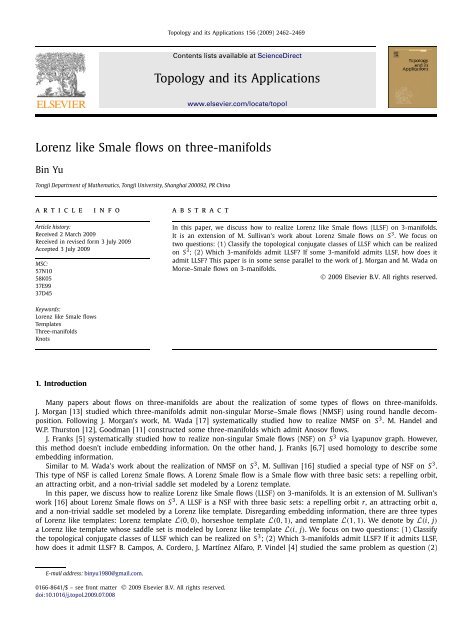
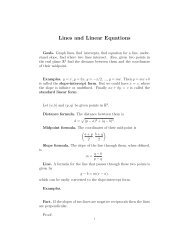
![Vector Calculus Summary [Draft]1 - Michael Sullivan](https://img.yumpu.com/42225362/1/190x245/vector-calculus-summary-draft1-michael-sullivan.jpg?quality=85)
